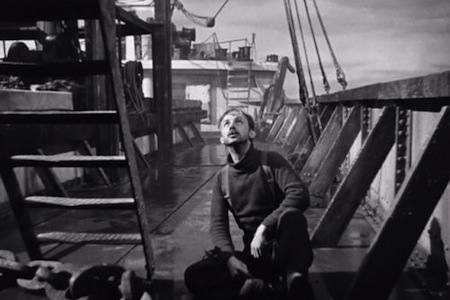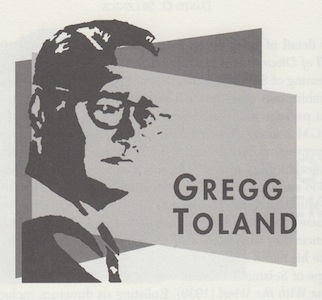Born: May 29, 1904, Charleston, IL
Died: September 28, 1948, Hollywood, CA
Toland demonstrated how the cinematographer can and should suit his style to the feel of the script.
—Kenneth MacGowan
Gregg Toland has been called the greatest cameraman ever to work in films. At fifteen, he was hired as an office boy for William Fox, working his way through various jobs until he was assisting camera operators on large productions. When he wasn’t busy on a movie set, he was tinkering with the tools of his craft, learning about photographic lenses and camera mechanics. By the time he was twenty-seven years old, he had become the youngest cameraman ever assigned to a first unit in Hollywood. Three years later, Toland’s experiments had made him so popular that Samuel Goldwyn was forced to share his prized innovator with other studios or risk losing him.
Although he developed many of his skills in the silent era, the talkies made Toland a Hollywood hero. In the days of silent film, cameras were clumsy and noisy, which was tolerated at the time because the final product didn’t require a soundtrack. But when sound films came into vogue, the loud camera ticks prevented acceptable recordings of the actors’ voices. Sound equipment had to be kept far away from camera equipment, and this made some productions unbearably complicated and time-consuming. Toland devised ways of improving equipment to rectify this problem. In 1928, he invented a soundproof blimp-like housing that covered a camera and ensured that its mechanized noise would not reach recording devices. This development was significant for sound pictures because it allowed directors to close in on intimate moments between actors and capture their whispers without capturing the whir of winding film. The soundproof camera instantly became a standard throughout the industry.
Recording brought Toland great opportunities. He went to work on some of the most beautiful films of the thirties. He was assigned as lead cameraman on Dead End (1937), and his Oscar-winning work on Wuthering Heights (1939) and contributions to Intermezzo (1939) made him a sought-after name in Hollywood. Working with director John Ford on The Grapes of Wrath (1940), Toland would make technical experiments that would lay the foundation for another Ford film, The Long Voyage Home (1940).
A startling example of expressionistic black-and-white contrast photography, The Long Voyage Home introduced razor-sharp images to the screen. Toland obtained this powerful clarity by using coated lenses, which he had custom-made for the film, and high-powered arc lamps. In effect, the lens could keep objects in the foreground and background of a shot in focus at the same time. The achievement was dubbed “deep focus.” And the innovation would become the most famous in Toland’s career. Unfortunately, explaining the benefits of deep-focus photography to Ford proved impossible. The stubborn director followed his own path in moviemaking and wasn’t interested in exploring Toland’s new compositions. Toland would have to wait for another chance to demonstrate the benefits of deep focus.
When Toland heard that the young Orson Welles was coming to Hollywood, he volunteered his services to RKO and introduced himself to the newcomer. Welles was exceptionally open-minded about Toland’s exciting new ideas, and soon they were put to the test on Citizen Kane (1940), the film that showcased the benefits of Toland’s deep-focus lenses. The clear photography gave audiences a chance to examine Orson Welles’s masterpiece to exhaustion, maintain a rich and realistic look that exaggerated the sense of space in many scenes. Welles cleverly adapted his sets to highlight the benefits of deep focus, and he choreographed certain scenes to use the new lenses to create some powerful effects. In one sequence of the film, the title character, Charles Foster Kane, discusses his financial affairs with two men in a foreground set, then wanders far into the background to stand in front of several towering windows. The scene accomplishes two interesting visual tricks through deep focus: it allows the actors to carry on a dialogue in different planes without requiring editing, and it creates an optical illusion of small office windows that are revealed to be enormous as Kane retreats into the background.
Although Toland’s deep-focus photography was slow to catch on with most Hollywood features, his own work on The Little Foxes (1941) and The Best Years of Our Lives (1946) employed it to award-winning success.
Toland continued to innovate through the years. He converted the lightweight and flexible Mitchell BNC camera, a model that found favor among television studios, for use on film sets. This camera was the outstanding choice for mise-en-scène, a style of shooting in which constant movement of actors through a set often requires the camera operator to adapt quickly. With greater camera control, Toland was able to satisfy a director’s instructions for unprecedented perspective shots or fluid movement. This eliminated the reliance on editing to intercut between scenes and sparked a new trend in film structure; directors planned long continuous shots around the new mobility. Toland also developed a new antinoise device built into the housing of the camera, negating his own blimp invention and creating yet another industry standard.
Camera operators often wind up becoming directors, using the position as a stepping-stone to greater things, as many of the people on this list have already proven. But among those who chose the craft of photography as their lifelong pursuit, few have equaled Gregg Toland. Only the legendary achievements of Billy Bitzer and the widespread application of Linwood Dunn’s optical printer have earned higher rankings here. Although most of Toland’s techniques were applied to their fullest in television, he is best remembered for his far-reaching impact on some of the greatest films in Hollywood’s golden age, and cameramen in both mediums still hold Toland in the highest esteem for his many innovations.
To read all the republished articles from ‘The Film 100,’ go to Reintroducing the Film 100 here on Keyframe.





